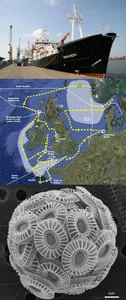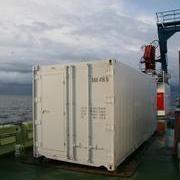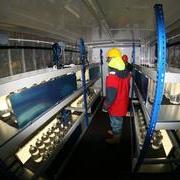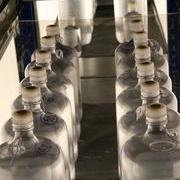
Today has been a red-letter day in the cruise calendar, with two major activities starting up. Through the first half of the night the ship steamed further north towards the Outer Hebrides, in the weather forecast area “Hebrides”, unsurprisingly. Eventually we arrived at our target site close to the islands of Mingulay and Barra.

At 2am, in near-complete darkness, the CTD was lowered into the water. It carried its normal complement of water sampling bottles. Unusually, all of them were made to collect water at exactly the same depth, from about six metres below the surface. This water was then brought back on to the ship and used for the first of our ‘bioassay experiments’.

A large group of bleary-eyed scientists (by now it was about 2.30am) dispensed the seawater from the 20-litre bottles on the CTD, using it to fill more than seventy 5-litre transparent polycarbonate bottles (the bottles need to have clear sides in order to admit light, so that the phytoplankton can continue to grow during the bioassay experiments). Most of the 5-litre bottles were then modified so as to raise the seawater CO2 and depress the seawater pH, representative of the state of the future ocean if we continue burning fossil fuels in prodigious amounts. The changes were implemented by injecting appropriate amounts of bicarbonate and acid into the bottles.

With such a large number of bottles, the task of organising it all is quite a challenge, with plenty of opportunities for mistakes to be made. However, it all went smoothly and efficiently, thanks to careful planning beforehand by Mark Moore and Sophie Richier, the bioassay chiefs.
One quarter of the bottles were adjusted to reproduce the impact of a future atmosphere containing 550ppm (parts per million) of CO2, one quarter to 750ppm, and one quarter to 1,000ppm. The remaining quarter were left as they are (present-day atmospheric CO2 is about 390ppm), to provide a comparison. All of the bottles were then carried into a purpose-built laboratory (a modified refrigerated shipping container, see photos) on the back deck of the ship. Within this laboratory, temperature and light intensity are controlled and are similar for all bottles.
In two days time we will again be very busy, when a whole suite of different measurements will be made on the bottles, to look for impacts of high CO2. Two days after that, a final set of measurements will be made.
Serendipitously, counting using a light microscope suggests that the water collected for the bioassays contains dense concentrations of coccolithophores (see the scanning electron microscope image above and to the right, below the cruise map). This is good news because coccolithophores, which build calcium-carbonate shells, are a group whose sensitivity to ocean acidification is strongly debated and which we are particularly keen to study.
The second major activity today was collection of deep-water corals, of which more in tomorrow’s blog entry.